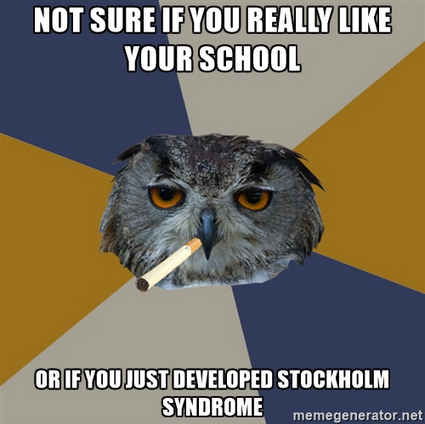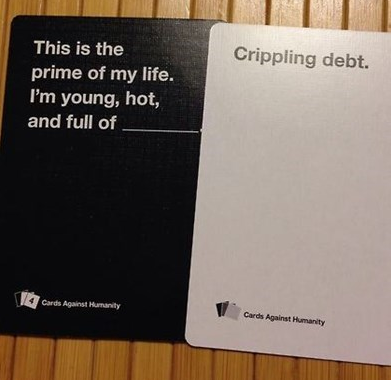
So, You Want a Photo MFA? Things to Consider!

You’ve been thinking about it for a while, and you think you might really kinda want to go for your master’s in photography. Good for you! But, before you dish out the time and the money for the applications fees, there are a few things to think about…
When I was thinking about the grad school thing, I wanted to go one place. I thought it was my dream program, in the best possible location, with funding and unicorns and rainbows and ice cream mountains. But, upon further review, it wasn’t my kind of program.
There are a few things to ask yourself when looking at programs:
Who are the faculty, what is their work like, do I want to work with them?
This was really important for me. Some schools have 5-star faculty, like UCLA has Catherine Opie, Yale has Gregory Crewdson, and MassArt has Abelardo Morell. Having these artists as a part of the faculty definitely brings in the applications.
But more schools have faculty that aren’t as famous. Look at their work, their CVs, and see if they are someone you want to learn from. Creepin’ is important at this stage of the process.
And, most importantly, do you want to work with these people? You will be at the mercy of your professors for 2-3 years, and you’re going to want those 2-3 years feel worthwhile and not completely miserable. The biggest turn off for my “dream school” was the way I was treated by their faculty.

Columbia College Chicago has a great mix of prolific photographers who are well known, like Dawoud Bey and Kelli Connell, and also wonderful mid-career artists like Ross Sawyers and Myra Greene. You can’t really go wrong when you have faculty who have active careers in the art world.
What does the work from the current MFA students look like?
Do some digging and find out who is currently in the program. Most school websites have a tab devoted to their grad student’s portfolios and/or websites. Check them out– please, really, do this. Pay attention to what you are seeing– does everyone’s work look similar? Are they all practicing the same concepts, or similar ones? Is there any experimentation? How about cross-media exploration?
It really, really matters to see what students are up to, because you can figure out the school’s philosophy and also gauge what kinds of resources they may have access to. The number one thing that sold me on Columbia College Chicago was the work the students were making. The photography program is incredibly diverse, and as a result I get feedback from all sorts of perspectives. Win.
Do they offer funding?
I’m going to lay down some heavy truths here.
School is expensive. ESPECIALLY GRADUATE SCHOOL.
If you’re considering an MFA in Photography, you need to realize there is no guarantee you will become a well received artist, an associate or even tenure professor, or anything else. The field is highly competitive, and everyone is good. So, if you take out $70K in loans and end up working at a job that makes $30K a year, I have sad news for you.
Do not start your art career off in debt. You will be too busy paying off those school bills and won’t have the time or monetary resources to produce work. Please, please, please don’t do this. It isn’t worth it.

So, do your research. State schools and universities typically offer nice scholarships, even full rides with additional stipends. There are some great opportunities, but these spots are also highly competitive.
Private schools and universities typically cost more, and they also don’t give as much money as public institutions. If funding is a huge priority for you, look into the sorts of funding schools offer.
One of the nice things about Columbia is that even though it is a private institution, there are awesome scholarship opportunities. In the Photo MFA program, there is an award called the “Graduate Merit Award,” which covers 100% of your tuition. All 60 credits! This was one of my major factors when deciding where to go.
A lot of advisors from these schools will tell you that they “will find you aid,” but that just means they will help you get loans. Yikes.
How about Graduate Assistantships? Can I teach?
Graduate Assistantships are hard to come by. I’m not delusional, or lying to you– they really, really are. Some schools, everyone that gets in gets a GA, but that may be because the program admits 2-4 people a year. Other schools you don’t get a GA your first year, and you have to apply for it/compete for it your second year. And, there are schools that don’t have any at all, since they “want their students to focus on their art.” Yeah, okay.
Some assistantships range from administrative work, office work, gallery work, and archival work. Currently, I have a teaching assistantship in a photography history class. Now, I don’t get the opportunity to run my own classes 24/7, but I have coordinated with the professor I’m assisting to be able to lead one or two classes this semester. If you’re feeling like Columbia is for you, the professors here are almost always willing to help you do what you want to do, especially when it comes to teaching!
The most important thing when choosing your program is to check in with yourself and listen to your gut. I could give you advice all day (and trust me, I could write about this forever) but at the end of the day, everyone has different needs.
I hope this post helps you at least a little bit in your journey to graduate school! Good luck!
Image Sources:
http://fyeahartstudentowl.tumblr.com/
https://www.pinterest.com/pin/492510909224631382/
www.kellyjbaker.com/wp-content/uploads/2014/10/istockgraduationmortarboards.jpg
